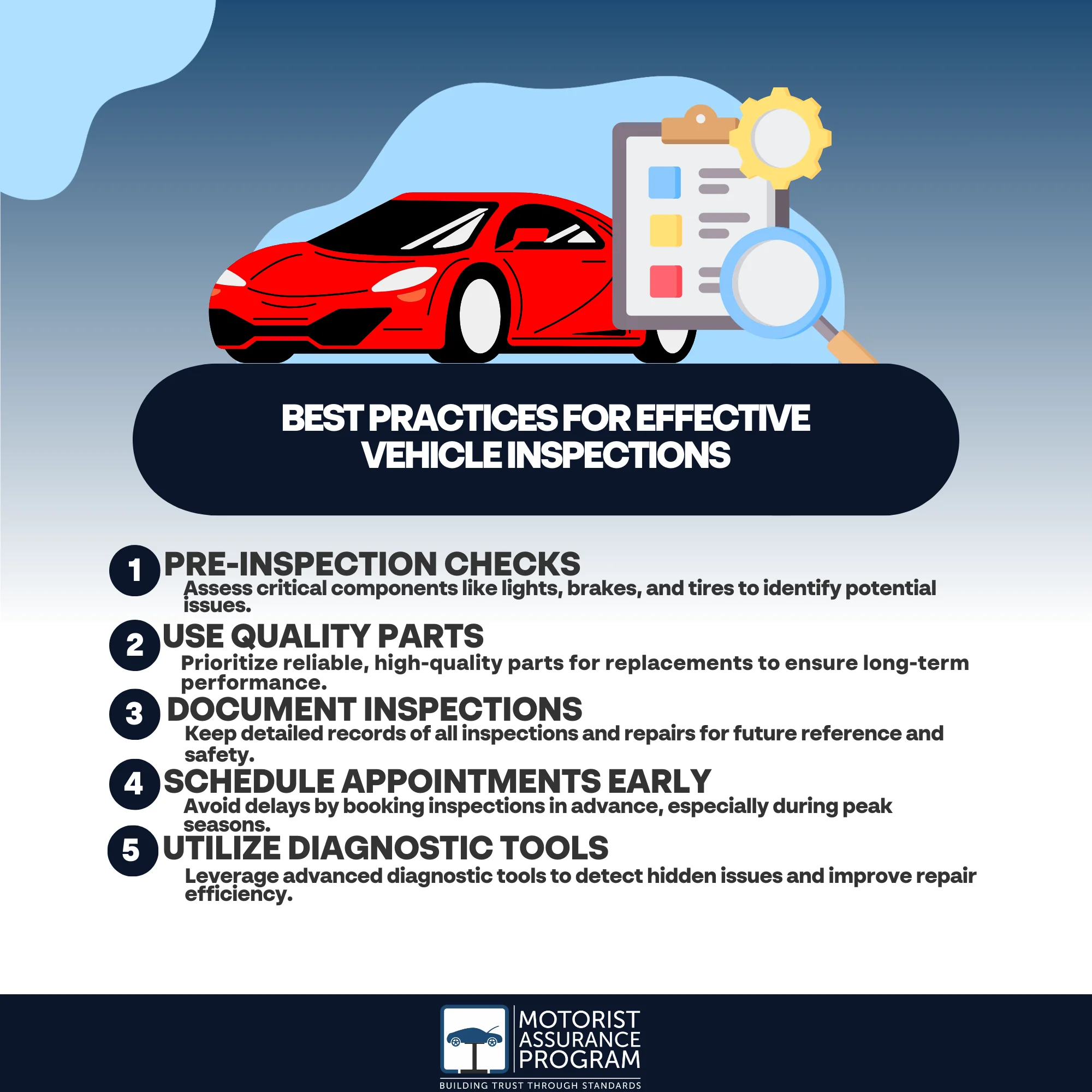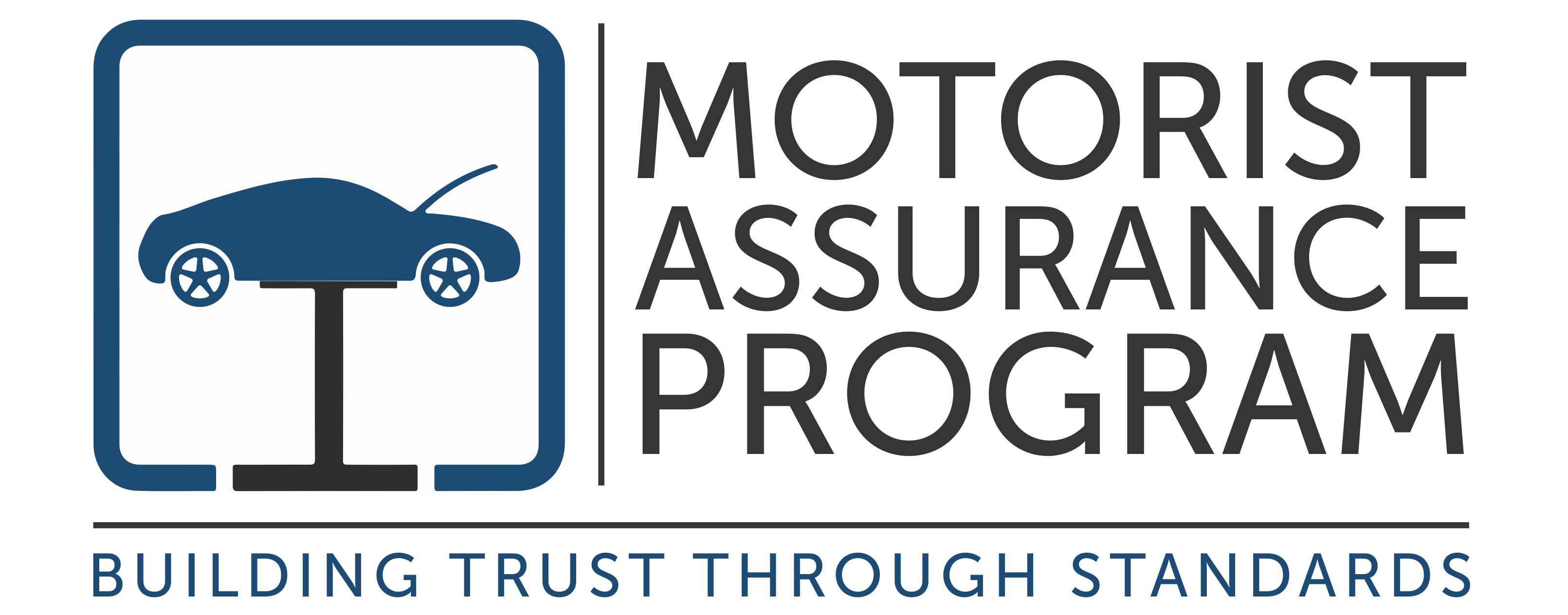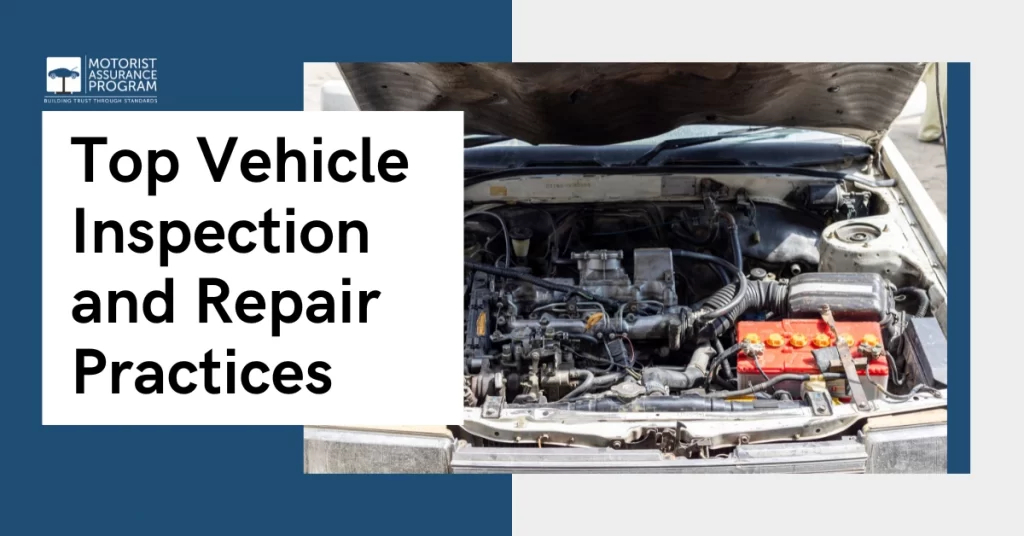To keep your vehicle running safely and efficiently, prioritize regular inspections and proactive maintenance. Start by gathering all necessary documentation, like your vehicle history and maintenance records. Conduct pre-inspection checks on critical components such as lights, brakes, and tires to catch issues early. Always select quality replacement parts based on reliability and warranty. It’s crucial to maintain a detailed record of inspections and repairs, as this helps with future maintenance decisions. Engaging in these practices not only elevates performance but also saves you money in the long run. Stick around, and there’s more valuable information ahead!

Key Takeaways
-
Regular inspections enhance safety, extend vehicle longevity, and lead to cost savings by identifying small issues before they escalate.
-
Gather necessary documentation, such as vehicle history and inspection records, to streamline the inspection process and improve preparedness.
-
Conduct a pre-inspection check on critical components like lights, brakes, and tires to identify potential issues early.
-
Utilize advanced diagnostic tools to quickly identify problems and improve repair efficiency with data analysis and sensor calibration.
-
Prioritize safety in repairs by addressing critical issues first, based on thorough documentation of inspection findings.
Importance of Regular Inspections
Regular inspections of your vehicle are crucial for both safety and longevity. By keeping a close eye on your car’s condition, you not only increase your safety but also extend its life.
A well-maintained vehicle runs better, consumes less fuel, and experiences fewer breakdowns. This proactive approach leads to significant cost savings in the long run, as small issues are caught before they escalate into major problems.
When you regularly inspect your vehicle, you’re ensuring that all components, from brakes to tires, are functioning efficiently. This attention to detail not only boosts your vehicle’s performance but also contributes to its longevity.
Routine inspections often reveal potential pitfalls that could result in costly repairs if left unchecked.
Preparing for Vehicle Inspections
Preparing for vehicle inspections guarantees a smooth process and helps to avoid any surprises. Start by gathering all necessary documentation, like your registration and insurance, so you’re ready when the time comes.
It’s also important to conduct a pre-inspection check to identify any potential issues before your appointment. Regular vehicle inspections can increase safety and reduce the likelihood of mechanical failures on the road, assuring compliance with regulations regarding vehicle inspections and maintenance.
Don’t forget to schedule your appointment early to keep your vehicle in top shape and minimize any potential delays.
Gather Necessary Documentation
Before you head to the inspection station, it’s crucial to gather all necessary documentation to guarantee a smooth process. Start by collecting your vehicle history report. This report provides key insights into any previous accidents, repairs, or issues that could affect your inspection outcome. Having this information on hand can help you address potential concerns before they arise.
Next, verify you have your inspection records ready. These documents show any previous inspections your vehicle has undergone, including any repairs or maintenance performed. If your vehicle has passed inspections in the past, these records can serve as proof of its reliability and condition, potentially making the current inspection easier.
Don’t forget to include your registration and proof of insurance, as these are often required as well. Having everything organized can make you feel more confident and prepared.
Conduct Pre-Inspection Check
Conducting a pre-inspection check can greatly boost your vehicle’s chances of passing the inspection with flying colors. By taking a little time to assess your vehicle beforehand, you can identify potential issues that could cause problems during the official inspection.
Start with a pre-inspection checklist, which covers essential components like lights, brakes, tires, and wipers.Utilize visual inspection techniques to examine each area thoroughly.
For instance, check your headlights and taillights to verify they function properly and aren’t cracked. Inspect your tires for adequate tread depth and proper inflation. Examine the windshield for any cracks or chips that might need repair.
Check under the hood, where you can look for leaks in fluids and verify belts and hoses are in good condition. A few minutes spent on these checks can save you from costly repairs or a failed inspection.
Schedule Appointments Early
To guarantee a smooth vehicle inspection process, you should schedule your appointments early. When you plan ahead, you not only secure a spot that fits your schedule but also gain peace of mind.
It’s crucial to take into account that inspection centers can get busy, especially during peak times. By booking in advance, you’ll avoid the last-minute stress that often comes with waiting until the last minute.
Utilizing appointment reminders can further enhance your experience. Set alerts on your phone or calendar to make sure you’re prepared and don’t miss your slot. This simple practice keeps your inspection on your radar and helps you manage your time effectively.
Having a bit of scheduling flexibility can also be beneficial. If your first choice isn’t available, being open to alternative times or locations can lead to a smoother process.
Common Inspection Checklist Items
When you think about vehicle inspections, it’s important to focus on common checklist items that keep your car safe and efficient.
Start by evaluating the brake system, reviewing tire condition, and checking fluid levels, as these factors play a significant role in your vehicle’s performance.
Regular fluid checks are essential for maintaining engine health, so don’t forget to monitor your radiator coolant, transmission fluid, and motor oil levels.
Brake System Evaluation
A thorough brake system evaluation is essential for guaranteeing vehicle safety and performance. Regular inspections can help you catch issues before they become serious problems, making your vehicle safer to drive.
Here’s a checklist to guide your brake system evaluation:
-
Brake Pad Types: Check the condition of your brake pads. Different types can wear differently, so understanding what you have will aid in maintenance.
-
Brake Fluid Maintenance: Inspect the brake fluid level and quality. Contaminated fluid can lead to poor brake performance, so verify it’s clean and at the right level.
-
Brake Line Inspection: Look for any signs of wear or damage in the brake lines. A compromised line can lead to brake failure.
Tire Condition Assessment
Inspecting your tires regularly is vital for maintaining safe driving conditions. Start by checking the tire tread; it should have enough depth to guarantee proper grip, especially during seasonal changes. Look for signs of tread wear, as uneven wear can indicate alignment issues or the need for rotation. Adhering to a rotation schedule helps extend tire life and enhances performance.
Next, assess tire pressure. Under-inflated tires can lead to poor fuel efficiency and increased wear, while over-inflated tires can compromise traction.
Don’t forget to take into account tire age; even if they look fine, tires older than six years should be replaced to avoid potential blowouts.
Examine your tires for sidewall damage, such as cuts or bulges, which can jeopardize safety. If you use performance tires or eco-friendly tires, be mindful of their specific care requirements, as they might wear differently.
Fluid Levels Check
Keeping an eye on various fluid types can prevent costly repairs and guarantee safe driving. You should regularly check these essential fluids at set maintenance intervals to maximize your vehicle’s performance.
Here are three key fluid levels to monitor:
-
Engine Oil: This lubricates engine parts, preventing wear and tear. Check it regularly and change it based on your manufacturer’s recommendations.
-
Coolant: Vital for regulating engine temperature, low coolant can lead to overheating. Inspect the level and top it off as needed, especially before long trips.
-
Brake Fluid: This is critical for your braking system’s effectiveness. Low levels can compromise safety. Always verify it’s within the recommended range.
Understanding Warranty Considerations
Understanding warranty considerations is vital for any vehicle owner looking to maintain their car’s performance and value.
Being aware of your warranty coverage can save you money and guarantee your vehicle remains in top shape.
Here are three key points to keep in mind:
-
Know Your Coverage: Familiarize yourself with what your warranty covers. This includes parts, labor, and specific conditions under which the warranty remains valid.
-
Follow the Claim Process: If you encounter issues and need to file a claim, understand the steps involved. This often includes documentation, timelines, and specific forms you’ll need to submit.
-
Regular Maintenance: Adhering to a routine maintenance schedule can prevent issues that might void your warranty.
Keep records of all services performed; this documentation can be essential if you need to make a warranty claim.
Establishing a Maintenance Schedule
Establishing a maintenance schedule for your vehicle can keep it running at its best and prevent costly repairs down the line.
By planning regular check-ups, you guarantee that your car receives the attention it needs, increasing its life span and performance.
Here are three key steps to contemplate when creating your schedule:
-
Determine Maintenance Frequency: Refer to your owner’s manual for recommended service intervals. This will help you identify when oil changes, tire rotations, and other essential services are due.
-
Incorporate Scheduling Flexibility: Life can get busy, so build a schedule that allows for adjustments. If you can’t make an appointment, reschedule it promptly to avoid missing crucial maintenance.
-
Set Reminders: Use your phone or a calendar to set reminders for upcoming maintenance tasks. This will keep you accountable and guarantee you don’t overlook critical services.
Frequently Asked Questions
How Often Should I Replace My Vehicle’s Air Filter?
You should replace your vehicle’s air filter every 12,000 to 15,000 miles, depending on driving conditions. A clean filter improves performance, while a worn one can shorten the air filter lifespan and reduce engine efficiency.
What Is the Best Time of Year for Inspections?
Spring and fall are ideal for inspections, considering seasonal changes and how they affect your vehicle’s performance. Regular checks enhance safety and reliability.
Are There Any DIY Inspection Tips for Beginners?
If you’re a beginner, start with a basic inspection checklist. Use common DIY tools like a flashlight, tire gauge, and multimeter. Inspect fluids, brakes, and lights to verify your vehicle’s safe and running smoothly.
Can I Use Aftermarket Parts Instead of Oem?
Aftermarket advantages include cost savings, while OEM disadvantages often involve inflated prices. Just remember, you might be rolling the dice on quality.
How Do I Choose a Reputable Repair Shop?
To choose a reputable repair shop, read customer reviews to gauge experiences. Look for shops offering service warranties, as they demonstrate confidence in their work. Trust your instincts and prioritize quality over price.
Conclusion
Regular vehicle inspections aren’t just a checkbox on your to-do list; they’re your car’s way of asking for a little TLC. By embracing these top practices, you’re not only sidestepping costly repairs but also channeling your inner mechanic—without the grease stains. So, roll up your sleeves, stay proactive, and give your vehicle the attention it deserves. After all, a well-maintained car is a happy car, and who doesn’t want that?


